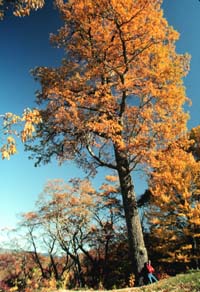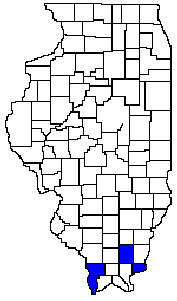 |
| Rock
Chestnut Oak (Quercus montana)
Distribution
Map to Right |

Rock chestnut oak is a medium-sized tree, growing to heights of 50 to 70 feet. It has a broad, dense crown, and a large trunk of up to 21/2 feet in diameter. In Illinois, rock chestnut oak grows on dry, rocky, wooded slopes that are frequently nutrient poor.
Interesting Facts
Rock chestnut oak is very fire-resistant and under most conditions is a slow growing tree. Like the other oaks, it reproduces from seed as well as stump sprouts. It produces large quantities of acorns almost every year and is an important food source for songbirds, ruffed grouse, wild turkey, mice, deer, and other mammals.
The wood of rock chestnut oak is very hard - harder than that of white oak.
Identifying Features
Bark
Rock chestnut oak bark is dark brown and furrowed. The ridges in between the furrows are slightly rounded, and the inner bark of the tree is reddish.
Buds
The buds are 1/4 to 1/2 inch long, pointed and hairy.
Leaves
The leaves are alternate and simple, and broadly lance shaped. They are typically from 4 to 9 inches long and up to 4 inches broad. They are pointed at the tip, narrowing toward the base, and have shallowly incised (indented), rounded teeth at the edges. They are leathery, smooth, and dark yellow-green on the surface and paler and hairy underneath.
Flowers
Male and female flowers occur on the same tree, but as separate flowers. Flowers occur as groups of slender catkins.
Fruits
The acorns occur singly or in pairs, are on a very short stalk and are up to 1 1/2 inches long. The acorn is chestnut brown and the cup is a reddish brown and covers less than half the length of the acorn.
Uses
The heavy, durable, close-grained wood is used for fence posts, fuel, and railroad ties. Tannin extract (used in making processing leather) is also derived from rock chestnut oak wood.